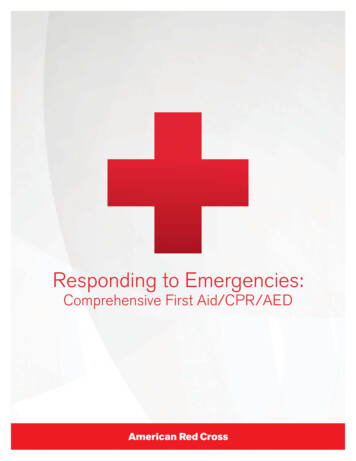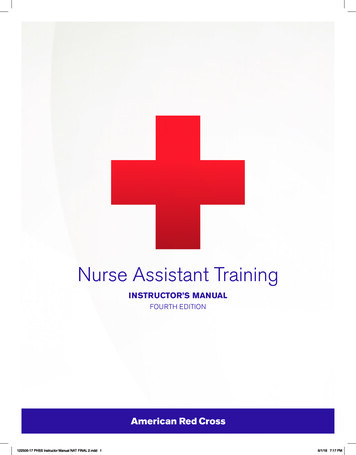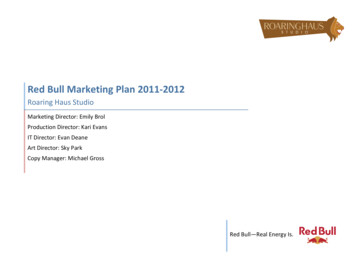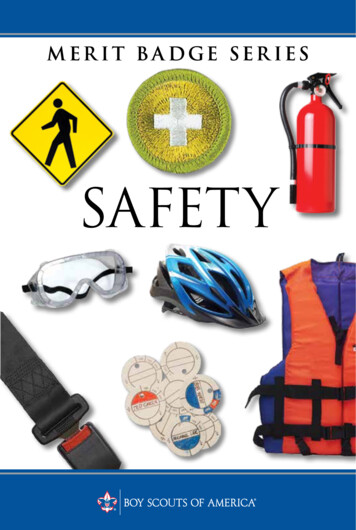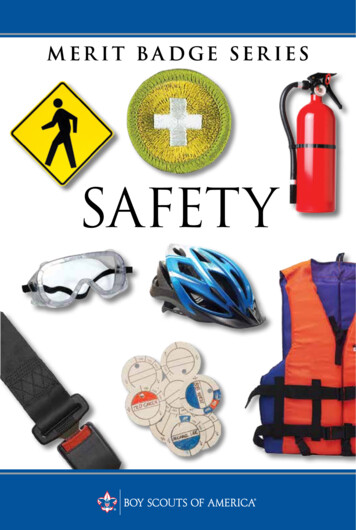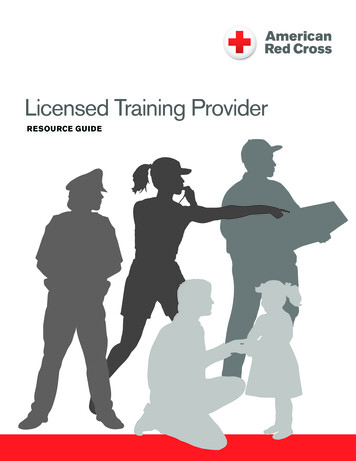
Transcription
Licensed Training ProviderRESOURCE GUIDE
Table of ContentsWelcome . . . . . . . . . . . . . . . . . . . . . . . . . . . . . . . . . . . . . . . . 3Purpose of the Resource Guide . . . . . . . . . . . . . . . . . . . . . . 4Being Part of the Red Cross . . . . . . . . . . . . . . . . . . . . . . . . 5Where to Get Assistance . . . . . . . . . . . . . . . . . . . . . . . . . . . 8The Role of the Red Cross LicensedTraining Provider . . . . . . . . . . . . . . . . . . . . . . . . . . . . . . . . . . 9Program Support . . . . . . . . . . . . . . . . . . . . . . . . . . . . . . . . . 15Supplies and Equipment . . . . . . . . . . . . . . . . . . . . . . . . . . . 18Promoting Red Cross Courses . . . . . . . . . . . . . . . . . . . . . 19Policies and Procedures . . . . . . . . . . . . . . . . . . . . . . . . . . . 22April 20132
WELCOMEThank you for choosing to be a Licensed Training Provider for theAmerican Red Cross. By entering into this relationship with theRed Cross, your organization has become not only an important partof the Preparedness and Health and Safety Services training team,but it has become part of a long tradition of providing quality educationthat saves lives throughout the United States dating back to 1909.As we work together there are some mutual commitments that serveas the basis for the obligations of the Red Cross and your organization.Our mutual commitments are to: Establish a relationship based on mutual respect and trust. Provide the American people with responsive, accessible,affordable and high-quality health and safety services,education and training in a professional manner. Contribute to the mission of the Red Cross by helping peopleprevent, prepare for and respond to emergencies. Help people lead safer, healthier lives.The Red Cross is committed to helping Licensed Training Providersoffer the highest quality training possible. In addition, the Red Crossoffers: Two-year certifications for first aid and CPR/AED and freequarterly digital refreshers to keep employees’ skills sharp.April 2013 A choice of free digital or affordable print course materials. Flexible training options that can adapt to your business’changing needs, including web-based learning and anationwide corporate training system that’s ideal if you havefacilities spanning multiple geographic locations. A web-based training management system for instructorsto manage course records and print certificates. Online ordering for training materials and products and adedicated instructor website with updated tools andresources. Optional training modules and lessons, blended learning,training supplies, first aid kits and more. Training that incorporates the latest science and educationalinnovation and meets OSHA guidelines.Welcome 3
PURPOSE OF THE RESOURCE GUIDEThis American Red Cross Licensed Training Provider Resource Guideprovides your organization with the basic information it needs to serveas an American Red Cross Licensed Training Provider. This includes: Where to get assistanceApril 2013 General Red Cross information Red Cross responsibilities to the Licensed Training Provider Licensed Training Provider responsibilities How best to support your instructors How to properly support the program How to get books, materials and equipment for conductingtraining Red Cross policies and procedures that affect the LicensedTraining Provider Support materials that Licensed Training Providers can use topromote Red Cross programsPurpose of the Resource Guide 4
BEING PART OF THE RED CROSSTHE INTERNATIONAL RED CROSSAND RED CRESCENT MOVEMENTThe International Red Cross Movement is the largest humanitarianvolunteer organization in the world, with more than 175 membercountries, of which the United States is one. Muslim countries preferto use the Red Crescent symbol. In June 2006 Magen David Adomand the Palestine Red Crescent Society were unanimously approvedmembership in the Federation. The goal of the movement is to preventand alleviate human pain and suffering. Seven Fundamental Principlesguide the direction for the movement, and all Red Cross and RedCrescent societies must adhere to them. These principles apply to youas a Licensed Training Provider.HumanityThe International Red Cross and Red Crescent Movement, born ofa desire to bring assistance without discrimination to the woundedon the battlefield, endeavors, in its international and national capacity,to prevent and alleviate human suffering wherever it may be found.Its purpose is to protect life and health and to ensure respect forthe human being. It promotes mutual understanding, friendship,cooperation and lasting peace amongst all peoples.ImpartialityIt makes no discrimination as to nationality, race, religious beliefs,class or political opinions. It endeavors to relieve the suffering ofindividuals, being guided solely by their needs, and to give priorityto the most urgent cases of distress.NeutralityIn order to continue to enjoy the confidence of all, the Movement maynot take sides in hostilities or engage at any time in controversies of apolitical, racial, religious or ideological nature.IndependenceThe Movement is independent. The national societies, while auxiliariesin the humanitarian services of their governments and subject to thelaws of their respective countries, must always maintain their autonomyso that they may be able at all times to act in accordance with theprinciples of the Movement.April 2013Being Part of the Red Cross 5
Voluntary ServiceIt is a voluntary relief movement not prompted in any manner by desirefor gain.UnityThere can be only one Red Cross or Red Crescent society in any onecountry. It must be open to all. It must carry on its humanitarian workthroughout its territory.UniversalityThe International Red Cross and Red Crescent Movement, in which allsocieties have equal status and share equal responsibilities and dutiesin helping each other, is worldwide.AMERICAN RED CROSSThe American Red Cross, founded in 1881 by Clara Barton, is a partof the International Red Cross and Red Crescent Movement.The Mission of the American Red Cross:The American Red Cross prevents and alleviates human suffering inthe face of emergencies by mobilizing the power of volunteers andthe generosity of donors.To support the mission of the American Red Cross, nearly 1.3 millionemployees and volunteers serve throughout the United States and itsterritories, and on military installations around the world. Supported bythe resources of a national organization, they form the largest volunteerservice and educational force in the nation. They help people prevent,prepare for and cope with emergencies, whether those emergenciesinvolve blood, disaster, social services, or health and safety. Thefollowing services are provided by the American Red Cross:PREPAREDNESS AND HEALTH ANDSAFETY SERVICESEvery year, the Red Cross trains some 11 million people in lifesavingskills. Red Cross first aid, CPR and AED programs are designed togive you the confidence to respond in an emergency situation withskills that can save a life. The American Red Cross has been the leaderin swimming and lifeguarding since 1914, and we teach preparednesscourses to help families and communities prepare for all kinds ofemergencies and disasters.April 2013Being Part of the Red Cross 6
SERVICE TO THE ARMED FORCESUsing the latest in computer and telecommunications technology,the Red Cross allows military members stationed all over the worldto send messages to loved ones back home during an emergencyor other important event. These communications are delivered aroundthe-clock, seven days a week, 365 days a year.BIOMEDICAL SERVICESThe American Red Cross provides nearly half of the nation’s bloodsupply (collecting 6.5 million units a year from volunteer donors) topatients in 2,500 hospitals across the country through its nationalnetwork. Every two seconds, someone in America needs blood. TheRed Cross must collect blood donations each and every day to meetthe needs of accident victims, cancer patients and children with blooddisorders, and the organization works to accomplish this through its35 Blood Services regions.DISASTER SERVICESEach year, the American Red Cross responds immediately to morethan 70,000 disasters, including house or apartment fires (themajority of disaster responses), hurricanes, floods, earthquakes,tornadoes, hazardous materials spills, transportation accidents,explosions and other natural and man-made disasters.Red Cross disaster relief focuses on meeting people’s immediateemergency disaster-caused needs. When a disaster threatens orstrikes, the Red Cross provides shelter, food and health and mentalhealth services to address basic human needs. The Red Cross alsofeeds emergency workers, handles inquiries from concerned familymembers outside the disaster area, provides blood and bloodproducts to disaster victims and helps those affected by disaster toaccess other available resources.INTERNATIONAL SERVICESAs part of the world’s largest humanitarian network, the AmericanRed Cross alleviates the suffering of victims of war, disaster andother international crises, and works with other Red Cross and RedCrescent societies to improve chronic, life-threatening conditions indeveloping nations. We reconnect families separated by emergenciesand educate the American public about international humanitarian law.More information about Red Cross services can be found atredcross.org.April 2013Being Part of the Red Cross 7
WHERE TO GET ASSISTANCERED CROSS REPRESENTATIVEYour American Red Cross contact isName, TitlePhone, E-mailTRAINING SUPPORT CENTER (TSC)A professional call center is available to assist licensed trainingproviders with: Course registrations (including instructor classes) Course record entry Issuing new and replacement certificates Ordering training supplies and equipmentYou may contact the training support center by phone at1-800-REDCROSS or by e-mail at support@redcrosstraining.org.The hours of operation for the training support center are:Monday - Friday from 7:00 a.m. to 11:00 pm. ETSaturday from 7:30 a.m. to 8:00 p.m. ETSunday from 10:00 a.m. to 6:00 p.m. ETINSTRUCTOR’S CORNERA website dedicated to certified American Red Cross instructors providesa wealth of tools and resources. Instructors and instructor trainers musthave an American Red Cross Learning Center account and be certifiedas an instructor to access Instructor’s Corner. These include: Instructor Tools and Teaching Aids—Find downloadable resourcessuch as electronic presentation tools, course codes, fact sheets,how to teach additional Red Cross programs, instructor remindersand more. Training Supplies—Order training supplies online 24 hours a day,7 days a week directly from our publisher, Krames StayWell. Enter course records in Saba or download course record forms,complete them electronically and then e-mail them to the TrainingSupport Center at support@redcrosstraining.org to expeditethe student certification process.Marketing and Promotional Materials—Download marketingtools to promote your Red Cross courses and programs. April 2013Visit Instructor’s Corner at redcross.org/instructorscorneror call (800) 667-2968.Where to Get Assistance 8
THE ROLE OF THE RED CROSS LICENSED TRAINING PROVIDERLicensed Training Providers have a long history of working with theAmerican Red Cross to provide training and information in first aid andCPR, swimming and water safety, and caregiving. Licensed trainingproviders are collaborators with the Red Cross in providing qualityHealth and Safety Services training in local communities. Whetherproviding training for their own employees, volunteers, clients ormembers of the community, Licensed Training Providers have anobligation to provide the highest quality training possible.As a Licensed Training Provider you have agreed, through the LicensedTraining Provider Agreement, to provide Red Cross instructional programsin accordance with the standards and objectives of the program. TheLicensed Training Provider Agreement provides an outline of the mutualexpectations, rights and responsibilities of both the Red Cross and theLicensed Training Provider. Following the guidelines in this documentensures the integrity of Red Cross programs and protects all partiesinvolved—the Licensed Training Provider, the Red Cross and the instructor.The agreement also outlines in writing how you will do business with theRed Cross.RED CROSS RESPONSIBILITIES TOTHE LICENSED TRAINING PROVIDERTo assist you in offering quality training, the Red Cross is committedto providing the following support to its Licensed Training Providers: Adhere to the terms of the Licensed Training ProviderAgreementApril 2013 Designate an individual to serve as your primary contact andprovide updates as needed Provide the finest programs based on research and inputfrom our customers Properly train your instructors Ensure the quality of the program through ongoingevaluations and program development Provide open communications with you Provide information that you need to offer quality trainingas well as meet your training responsibilities Provide services to you at a fair price, based on value Provide American Red Cross course completioncertificates in a timely manner Maintain your instructors’ recordsThe Role of the Red Cross Licensed Training Provider 9
Recertify your instructors who meet the criteria Maintain course records for seven years Develop course curriculum and materials Provide timely updates and information to instructors Provide technical assistance to instructors Provide a quality assurance program Give permission to use the Red Cross name and emblemin promotion of Red Cross instructional programs (in strictaccordance with the Licensed Training Provider Agreementand with Red Cross policies and procedures) Provide flyers, brochures, posters and other coursepromotional materialsLICENSED TRAINING PROVIDER’SRESPONSIBILITIESApril 2013As a Licensed Training Provider, you also have responsibilities that areoutlined in detail in the Licensed Training Provider Agreement. Thefollowing are the basic responsibilities of the Licensed Training Provider: Adhere to the terms of the Licensed Training ProviderAgreement Designate an individual to be the primary contact to theRed Cross and provide updates as needed Identify only individuals who are qualified to be instructorcandidates Submit properly completed records and reports in thedesignated time frames through the Red Cross Learning Center Keep the Red Cross informed of changes in an instructor’s status Support instructors’ adherence to Red Cross policies andprocedures Respect the copyrighted materials, the Red Cross name andemblem, other trademarks and proprietary content of theAmerican Red Cross Assist the Red Cross in resolving issues that may arise withinstructors Maintain a safe environment suitable for the delivery of theprograms Maintain open communications with the Red Cross Inform course participants that the training is an AmericanRed Cross course; the instructor should show visual RedCross identification during the training Ensure that course participants who have successfully met thecourse prerequisites, objectives and certification requirementsreceive American Red Cross certificates.The Role of the Red Cross Licensed Training Provider 10
INSTRUCTOR SUPPORTSuccessful training depends largely on the quality of the instructor.Both the American Red Cross and you have an obligation to supportyour instructor(s) in providing the best training possible.In accordance with the Licensed Training Provider Agreement, theRed Cross will provide the following support to your instructors: Provide effective, quality instructor training Provide effective evaluation Provide information on updates and program revisions Make available opportunities to volunteer for the AmericanRed Cross Provide opportunities for professional skill development byoffering periodic instructor upgrades, instructor in-services,additional instructor specialty courses and co-teachingopportunities Make available the proper materials and equipment needed toconduct training Ensure proper equipment is used during all coursesThe Licensed Training Provider also does the following to support aninstructor: Make an instructor available to the Red Cross for training,retraining and other professional development-related activities Supply Red Cross digital and/or print materials for supportof the courses Explore opportunities to potentially volunteer with the Red Cross Work with the Red Cross to ensure that quality instructiontakes place at its facility Ensure that the appropriate, qualified individuals are selectedto be trained as Red Cross instructors Maintain up-to-date contact information with the Red CrossINSTRUCTOR CERTIFICATIONCertification occurs when an instructor candidate successfullycompletes the instructor course and is issued an Instructor Certificatethat indicates that all requirements have been met on the date that theinstructor candidate completes the instructor course.April 2013The Role of the Red Cross Licensed Training Provider 11
Before an instructor can teach, the new instructor and a Red Crossrepresentative official must sign the Instructor Agreement and Codeof Conduct.Certified instructors who teach on behalf of your agreement must beindicated on Appendix C of the Licensed Training Provider Agreement.Under the terms of the Licensed Training Provider Agreement, theinstructor, as an employee or volunteer for the Licensed Training Provider,may provide training using Red Cross courses to the Licensed TrainingProvider’s employees, members and/or customers within the jurisdictionsoutlined in Appendix B of the Licensed Training Provider Agreement.SELECTING THE RIGHT INSTRUCTORCANDIDATETo ensure the quality of American Red Cross Health and Safety Servicestraining programs, it is important to select the appropriate person to enterthe instructor course. Here are some characteristics to consider: An excellent communicator and educator Knowledgeable about the subject taught Positive and enthusiastic attitude Patient and flexible Professional demeanor Committed to teaching Proficient public speaker ProactiveSUPPORTING INSTRUCTOR TRAINERDEVELOPMENT (PENDING APPROVAL)To maintain its reputation of providing the highest quality health and safetytraining available, the American Red Cross relies on identifying potentialcandidates to become instructor trainers. An instructor trainer candidate(ITC) is an experienced Red Cross instructor who has entered intotraining to become an instructor trainer (IT). Instructor trainers are certifiedby the Red Cross to conduct instructor courses and train new instructors.If your organization has a need to train instructors, you may want to inquireabout developing an instructor trainer for your organization.The process to train instructor trainer candidates has been designedto be flexible enough to take into consideration the knowledge andexperience a candidate possesses upon acceptance into the program.Training time may vary based on a candidate’s knowledge and experienceand the course(s) a candidate may wish to teach. The training ensuresthat an instructor trainer will serve as an effective representative of theRed Cross and will abide by the standards, policies and procedures ofApril 2013The Role of the Red Cross Licensed Training Provider 12
the organization. Candidates completing this process are then able totrain individuals as instructors and help increase the reach of Red Crosshealth and safety training programs. Contact your Red Crossrepresentative for complete details.QUALITY ASSURANCEQuality assurance in American Red Cross Health and SafetyServices programs is the responsibility of all parties: the Red Cross,the Licensed Training Provider and the instructor. The Red Cross isthe leader in quality health and safety training, and it maintains thatstatus by authorizing instructors who adhere to the training standardsand continually strive to provide exceptional training and service.You can help to maintain this high quality by using the following strategies: Choose the right individuals to become instructors Support instructors’ compliance with Red Cross policies andprocedures by making sure they have the proper equipment,space and time to conduct the training Make instructors available for additional training as necessary Review, take action and monitor the information received fromthe course evaluation forms Observe instructors when they teach Encourage instructors to co-teach with other Red Crosstrained instructorsThe Red Cross will also support you with its quality assurance efforts.In addition, the Red Cross takes steps to ensure its training standardsare maintained. These include: Providing high quality instructor trainingApril 2013 Establishing and explaining all national and local policies,regulations and procedures that relate to the instructor’sresponsibilities including the Instructor Agreement Making co-teaching opportunities available to instructors Monitoring of training records and other reporting forms forpotential problems Evaluating courses randomly by either surveying or observingthe teaching of instructors Providing technical support to instructorsThe Role of the Red Cross Licensed Training Provider 13
TRAINING ISSUESEven with the best planning and proactive quality assurance programs,problems may occur. When this happens, the Red Cross will workclosely with the Licensed Training Provider to immediately deal withthe situation.If a problem is minor, the Red Cross will try to deal directly with theinstructor to resolve the issue. Most situations can be handledeffectively with simple counseling.Occasionally issues arise that may need further intervention. Whenthis occurs the Red Cross will keep you informed of steps that arebeing taken by the Red Cross and will solicit your help in solving theproblem. The basic steps for dealing with larger issues are:1.2.3.4.5.Identifying the problemCounseling the instructorProviding remediation, if needed, such as co-teaching,teaching under observation or retrainingMonitoring the instructorContinuing counseling, remediation and monitoring asnecessaryIn severe cases, the Red Cross has the right to suspend aninstructor’s certification. When this occurs, the instructor can notteach Red Cross courses until the problem is resolved. When aresolution is not possible, the Red Cross may have no recourse butto withdraw the instructor’s certification. The Red Cross has anextensive and thorough process for withdrawal of certification anddoes not do this lightly.In situations where the Red Cross has identified that courses arenot taught according to standards and that the participants must beretrained, the Licensed Training Provider is responsible for all costsassociated with any retraining. (See the Licensed Training ProviderAgreement.) The Red Cross will notify the participants advising themof available retraining.April 2013The Role of the Red Cross Licensed Training Provider 14
PROGRAM SUPPORTLEARNING CENTERThe Learning Center provides instructors: Access to their records, including certificates and transcripts.Automatic training notices and alerts. Self-service course record entry. Ability to print student certificates of completion. Instructors and instructor trainers must have an American Red CrossLearning Center account and be certified as an instructor to accessInstructor’s Corner.Access the American Red Cross Learning Center atclasses.redcross.org/Saba/Web/Main. If you have difficulty logginginto the Learning Center, you may call 1-800-RED-CROSS.COURSE PLANNINGSince you are a valued customer of the American Red Cross, we want toensure that the training you conduct is fully supported. To that end, courseplanning is critical. If requested, Licensed Training Providers will notify theRed Cross of course dates and times prior to the scheduled start of thecourse. This process will help your organization by ensuring: Course materials are available. Promotional materials and marketing support are available to you.The Red Cross can assist with any other course planning necessaryto ensure the quality of your training programs.Blended learning courses can be offered by Licensed Training Providers,also. Blended learning courses involve both an online component andan in class component and are a great option when in-person trainingtime is limited. Information on how to set up a blended learning class,including instructor orientation to the online content and steps to takeahead of time, can be found on Instructor’s Corner: First Aid/CPR/AEDApril 2013 CPR/AED for Professionals LifeguardingProgram Support 15
REPORTING COURSE ACTIVITYCollection of information on course activity benefits both yourorganization and the Red Cross by: Providing records on students trained, which can also be usedby your organization to verify training. Providing statistics that help in program evaluation. Allowing the Red Cross and you to identify trends for possibleareas of improvement. Assisting in monitoring for quality assurance. Helping to ensure all areas of the community are reached withRed Cross programs. Tracking instructor activity for recertification and recognitionpurposes.SUBMIT TRAINING RECORDS THROUGHTHE LEARNING CENTERInstructors can submit training records electronically through theAmerican Red Cross Learning Center. It can be accessed atclasses.redcross.org/Saba/Web/Main. A job aide anddemonstration is also available.COURSE RECORDSYour organization is responsible for ensuring that your instructorssubmit training records through the Learning Center to the Red Crosswithin 10 business days of the completion of each class.OBTAINING COURSE COMPLETION CERTIFICATESMost Red Cross training programs have course completion certificates(cards) that are given to participants who successfully complete thetraining. When the training is submitted electronically in the LearningCenter, the instructor is able to print certificates after the course hasbeen approved by the Red Cross. You may also request certificates bemailed to the instructor.Instructors can also submit a Course Record or a program activityreport electronically by e-mail at support@redcrosstraining.org.Certificates will then be mailed to the instructor.April 2013Program Support 16
PAYMENT OPTIONS Credit Card and Bank Transfercccc Prepaymentcccccccc Licensed Training Providers (LTP) may choose to prepayby credit card, check, money order or bank transfer. APrepayment Request Form is available on Instructor’sCorner.For prepayment by check or money order, the LTP mails thePrepayment Request Form to the training support center (TSC).For prepayment by credit card and bank transfer, thePrepayment Request Form is sent to the training supportcenter and a TSC agent will call the LTP to collect theconfidential information.Licensed Training Providers can also place a call directlyto the TSC at 1-800-RED-CROSS and request to make aprepayment on their account if the payment method will bevia credit card or bank transfer.Invoicing - The American Red Cross will only invoice for coursefees greater than 500 per class.ccccApril 2013Credit card payments can be made at the time of courserecord submission via the American Red Cross LearningCenter.When course records are submitted via postal mail to the TSC,a TSC agent will follow up with the billing representative tosecure credit card or bank transfer information prior to courserecord processing.Licensed Training Providers whose per course fees aremore than 500 per class and have an excellent paymenthistory with the American Red Cross will be considered forinvoicing. If you meet both requirements you may completea Credit Approval Request Form and return it to your RedCross representative. Your representative will discuss nextsteps with you once they have processed your application.If your course fees do not meet the minimum 500 per classand your agency is required by state or federal regulation toreceive an invoice to process payment you may request anexception. Please contact your Red Cross representativeto discuss alternatives. You will be requested to supplydocumentation of the regulation.Program Support 17
SUPPLIES AND EQUIPMENTMany Red Cross training programs require a specific type of manual,specialized training equipment and videos. The instructor’s manualoutlines the specific text and equipment needs for each course.Maintaining the equipment ratios outlined in the instructor’s manualallows instructors to stay within the timelines for the training, as wellas providing course participants the time they need to properlypractice and learn skills. Most of the materials needed to conductRed Cross training are available directly from the Red Cross.COURSE MATERIALSTeaching materials such as participant texts, instructor’s manuals andvideos are available in digital format on Instructor’s Corner or for purchase.EQUIPMENTEquipment used in Red Cross training must be maintained in goodworking order to ensure participant safety and effective teaching.Equipment that is not in good working order detracts from the participant’swillingness to learn and practice effectively. All equipment used in RedCross training should be maintained according to manufacturer guidelines.Equipment such as CPR manikins should be cleaned after each useaccording to the manufacturer guidelines and properly cleaned betweeneach participant. More detail on manikin decontamination, includingCenters for Disease Control and Prevention (CDC) guid
The American Red Cross, founded in 1881 by Clara Barton, is a part of the International Red Cross and Red Crescent Movement . The Mission of the American Red Cross: The American Red Cross prevents and alleviates
